TOP-ten4Bicycles
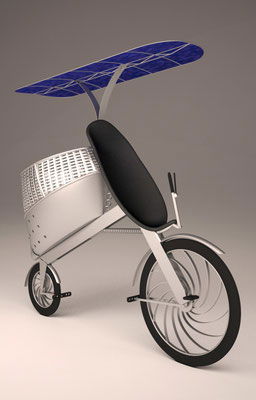
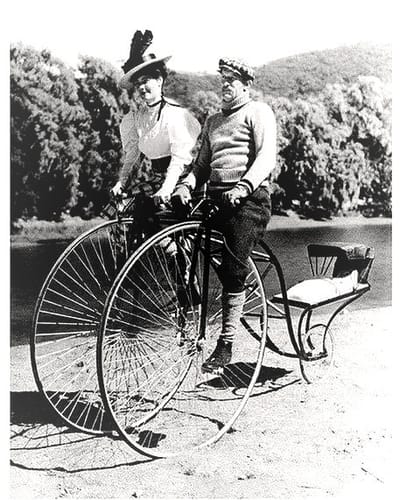
TOPten4Bicycles
and solar powered Cargo trailers - in Extension previous Vello world
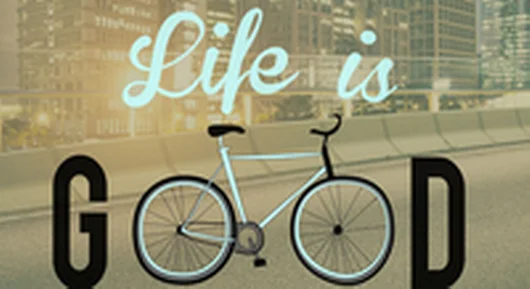
>> It was not buffalo-drawn carts with heavy, large wooden wheels that dragged China and India into the modern age; no, the carrying of countless loads on bicycles led (and in some cases still leads) them into the modern age. The challenge lies in the modern and all-weather creation of bikes in order to offer a good contemporary alternative to car use <<
These patent-free proposals from TOPten4Bikes are aimed in particular at bicycle manufacturers, their suppliers and talented hobbyists..
= = =
I am passionate about developing something further until it could work like this. This is how this concept about fahrRAD new reimagined; from T O P t e n 4 Bicycles - in evolution of the previous bicycle world and to encourage people to do without their cars more often.
1) Strength lies in rest
A classic "saddle" requires us to sit or work in an awkward, bent-forward position; and recumbents position the rider too close to the tarmac. A slightly inclined backrest, on the other hand, ensures a comfortable and optimally supportive posture. The handlebars are positioned closer to the rider in an "Easy Rider-like" manner, as the saddle position is also shifted slightly backwards to improve ergonomics.
Advantages of the comfortably reclined sofa seat:
+ Hi making active pedalling more powerful, efficient and at the same time ergonomically relaxed
+ By shifting the centre of gravity to the rear, you won't tumble headfirst over the handlebars in the event of a collision or incorrect braking
+ An (optional) seat belt offers real full protection. The belt would be anchored to the tubular frame of an expanded metal shell backrest; it may also make wearing a helmet unnecessary
2) In the heat and rain
Who likes cycling in the rain or in extreme heat? Hardly anyone! The fact is that our city bikes, cargo bikes and touring bikes only offer a high level of everyday riding comfort if they also added protect us from rain or direct sunlight.
An attachable protective roof would encourage us to leave the car in the garage more often.
As an option, a PV film stretched over the aluminium roof frame could (instead of only with Perlon) also supply a considerable proportion of the drive energy. Some companies offer these lightweight, rollable films*. The electricity generated on the approx. 1.1 m² roof could be fed directly into the solar battery installed in the bicycle frame. The approx. 150W of the PV film can harvest electricity during the day (even in diffuse light conditions). The frame and foil are rolled or foldable.
The lightweight, removable horizontal-roof is wind-slippery, because even changing winds are actually flat. During a longer test phase, I rode one without any problems - even in strong gusts of wind.
The approx. 60 x 180 cm roof extends far forwards to protect against rain and thus ensures dry paths. A wind and sight-permeable mesh blind protects against both rain and side sun. If required, it can be attached to the roof frame with Velcro. This blind has a lead tape at the lower hem and hangs down approx. 55 cm.
Sporty cyclists might also like this roof without electric drive (covered with perlon cloth instead of PV film, weighs nearly 400g).
This clip-on roof would also be a gain for retrofitting.
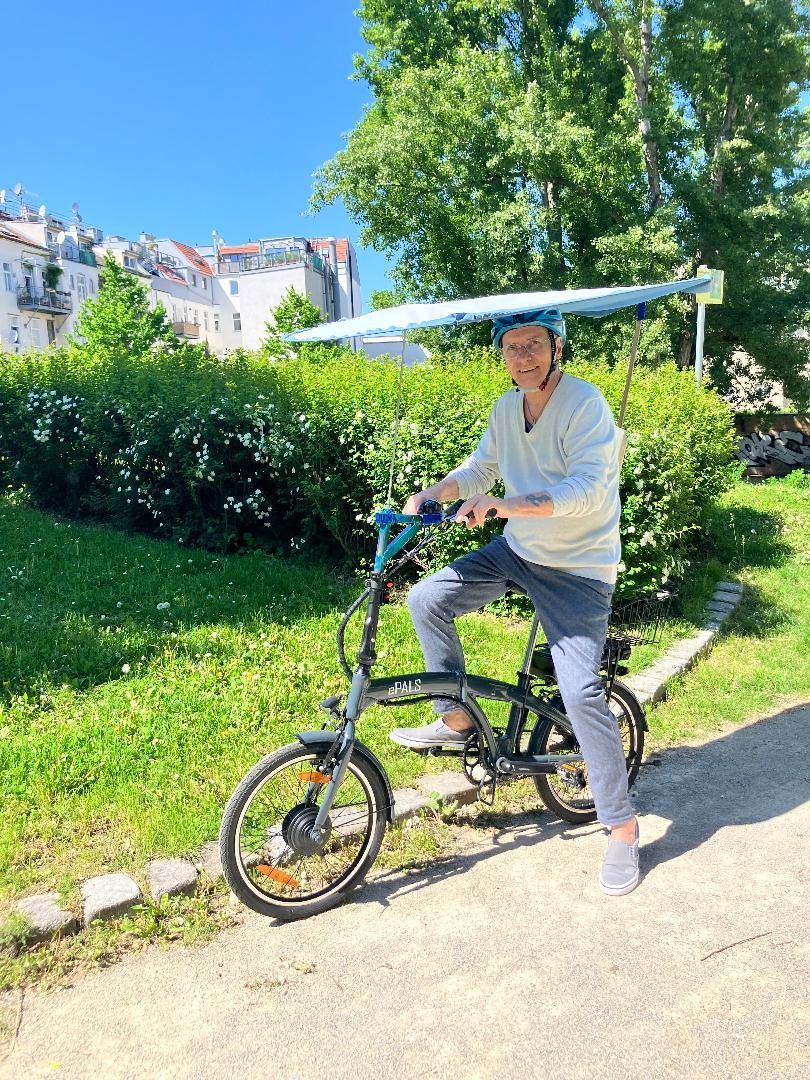
3) Ow, my Butt
Conventional saddles are actually quite uncomfortable, painful and unhealthy, especially on longer journeys.
A saddle can also be made up of two long, well-fitting buttock parts that are mounted next to each other on an axle.
These follow the bobbing pedalling movement of the rider. A "rocker saddle" of this type increases seating comfort for both men and women by providing noticeable relief in the sensitive crotch area.
4) Airless tyres?
My idea of a new type of tyre made of a harder rubber compound requires neither the usual rim bead wire nor fabric inserts - neither an inner tube nor internal air overpressure.

What the low-profile tyre does for a car, the following sketched carcass profile section could do for a bicycle:
This type of tyre is already cushioned by its thick-walled hard rubber cross-section profile (see drawing). In the event of higher loads, these tyres can still be inflated accordingly.
In addition, a small, narrow, central rolling bead offers perfectly minimised rolling resistance. The lateral auxiliary beads, optimised for grip, roll in contact with the ground when cornering at an angle.
This fahrRAD tyre has a two-piece "bolt-on rim" for tyre mounting, which ensures a perfect and positive tyre fit.
There is also no need to inflate the tyres or to "pick out patches" with this nail-proof model.
What's more, the wire- and fabric-free material is easy to recycle and can be reused as granulate! These tyres are particularly durable on rough terrain and when transporting loads, and require few repairs.
This type of tyre is already cushioned by its thick-walled hard rubber cross-section profile (see drawing). In the event of higher loads, these tyres can still be inflated accordingly.
In addition, a small, narrow, central rolling bead offers perfectly minimised rolling resistance. The lateral auxiliary beads, optimised for grip, roll in contact with the ground when cornering at an angle.
This fahrRAD tyre has a two-piece "bolt-on rim" for tyre mounting, which ensures a perfect and positive tyre fit.
There is also no need to inflate the tyres or to "pick out patches" with this nail-proof model.
What's more, the wire- and fabric-free material is easy to recycle and can be reused as granulate! These tyres are particularly durable on rough terrain and when transporting loads, and require few repairs.
5) The hand protector
In order to avoid the usual micro-traumas in the wrist, a cylindrical, elastomer pipe plug connection could be embedded in each of the steering grips and their transitions to the steering bar to minimise impact. This rigid-elastic bridge could be offered differently to the weight of a person (or it could be recessed to a different depth).
6) Laboriously spoking a bike is a thing of the past ...
A back-friendly side effect of the newly designed fahrRAD: the rear wheel can optionally be fitted with 12 conical fibreglass arch springs or steel leaf springs - instead of the usual spokes - for effective shock absorption. Other shock absorbers (for front and rear) also make a bike more expensive. Due to the rear wheel's centre of gravity, this approach only requires damping there. In principle, pushchairs can also be fitted with such wheels.
7) Long finger lock
The bike can be attached and secured against theft with a long steel cable lock that can be pulled out of the frame. A second quick immobiliser would be just as practical and practical.
It should be possible to secure the steel cable lock, battery, storage basket and solar roof with just one key. Even better would be a manual transmitter lock - which locks everything centrally, as has long been the case with cars.
8) The small cargo bike
The market for cargo bikes is diverse, but all cargo bikes are quite expensive to buy and have a bulky, long design.
As an alternative to these bikes, any normal bike could accommodate the following cargo basket behind the saddle:
A clip-on basket measuring approx. 60x140x55 (W, H, L) cm, which can be made from woven willow in the interests of ecological sustainability. This natural material is somewhat lighter in weight than aluminium expanded metal, for example, and could be structured as a wide-open net. This dimension would offer 420 litres of secured load volume. The floor is made of 4 mm thick beech plywood with an 8 mm thick edge reinforcement, and it is connected at the corners with four swivel castors.
In order to avoid the usual micro-traumas in the wrist, a cylindrical, elastomer pipe plug connection could be embedded in each of the steering grips and their transitions to the steering bar to minimise impact. This rigid-elastic bridge could be offered differently to the weight of a person (or it could be recessed to a different depth).
6) Laboriously spoking a bike is a thing of the past ...
A back-friendly side effect of the newly designed fahrRAD: the rear wheel can optionally be fitted with 12 conical fibreglass arch springs or steel leaf springs - instead of the usual spokes - for effective shock absorption. Other shock absorbers (for front and rear) also make a bike more expensive. Due to the rear wheel's centre of gravity, this approach only requires damping there. In principle, pushchairs can also be fitted with such wheels.
7) Long finger lock
The bike can be attached and secured against theft with a long steel cable lock that can be pulled out of the frame. A second quick immobiliser would be just as practical and practical.
It should be possible to secure the steel cable lock, battery, storage basket and solar roof with just one key. Even better would be a manual transmitter lock - which locks everything centrally, as has long been the case with cars.
8) The small cargo bike
The market for cargo bikes is diverse, but all cargo bikes are quite expensive to buy and have a bulky, long design.
As an alternative to these bikes, any normal bike could accommodate the following cargo basket behind the saddle:
A clip-on basket measuring approx. 60x140x55 (W, H, L) cm, which can be made from woven willow in the interests of ecological sustainability. This natural material is somewhat lighter in weight than aluminium expanded metal, for example, and could be structured as a wide-open net. This dimension would offer 420 litres of secured load volume. The floor is made of 4 mm thick beech plywood with an 8 mm thick edge reinforcement, and it is connected at the corners with four swivel castors.
The wicker basket is hooked onto the seat tube and snapped onto the two seat stays of the rear frame with a tug. The basket is loaded and unloaded via its lockable tailgate. If required, a rainproof cover keeps the transported goods dry.
It can also be used as a practical shopping trolley (approx. 60x90x50 cm, 240 litres) made of wicker.
When removed from the wheel, this type of basket can be easily pushed on its wheels like a suitcase.
In addition, a 30x30 cm "balcony carrier", which is attached to the fork steerer tube, can hold further luggage. The luggage is attached to this carrier with rubber clips and placed in the centre of the frame - at every steering angle. If required, this carrier also provides a statically favourable load balance to the rear load basket.
This type of mesh basket also competes favourably with expensive, bulky cargo bikes and helps budding delivery drivers on their way to self-employment. And if you leave the basket at home, you can use your bike as usual.
* Furthermore, there are several billion plastic suitcases, mostly produced in East Asia, in households around the world, and soon afterwards in landfill sites. They should be replaced by three interlocking, durable travelling suitcases made of wicker. These would save us from tens of thousands of tonnes of plastic waste and its decomposition into microplastics; and most importantly, end the ongoing polluting, foul-smelling plastic suitcase trade. It would also revitalise an ancient craft.
----
With a pleasing inner fabric and colourful oilcloth weather cover, this wicker trolley would be another sustainable utility item for a more ecological lifestyle.
DIY kits including instructions could also be ordered as raw material. This way you could make your own basket. Can't be too difficult - can it?
9.) Heavy-duty trailer
It can also be used as a practical shopping trolley (approx. 60x90x50 cm, 240 litres) made of wicker.
When removed from the wheel, this type of basket can be easily pushed on its wheels like a suitcase.
In addition, a 30x30 cm "balcony carrier", which is attached to the fork steerer tube, can hold further luggage. The luggage is attached to this carrier with rubber clips and placed in the centre of the frame - at every steering angle. If required, this carrier also provides a statically favourable load balance to the rear load basket.
This type of mesh basket also competes favourably with expensive, bulky cargo bikes and helps budding delivery drivers on their way to self-employment. And if you leave the basket at home, you can use your bike as usual.
* Furthermore, there are several billion plastic suitcases, mostly produced in East Asia, in households around the world, and soon afterwards in landfill sites. They should be replaced by three interlocking, durable travelling suitcases made of wicker. These would save us from tens of thousands of tonnes of plastic waste and its decomposition into microplastics; and most importantly, end the ongoing polluting, foul-smelling plastic suitcase trade. It would also revitalise an ancient craft.
----
With a pleasing inner fabric and colourful oilcloth weather cover, this wicker trolley would be another sustainable utility item for a more ecological lifestyle.
DIY kits including instructions could also be ordered as raw material. This way you could make your own basket. Can't be too difficult - can it?
9.) Heavy-duty trailer
This is a trailer similar to a low-loader, which is steered via the fahrRAD or an e-bike. It provides CO²-free delivery and possibly also taxi services and is specially designed for today's climate situation.
This 2.9 metre long trailer runs on a 125 cm wide track and weighs approx. 100 kg.
Just behind the height-adjustable drawbar, two ~ 35 cm twin tyred wheels take the load off the turntable base. The load weight is thus distributed over eight wheels (with the two additional 60 cm twin rear wheels).
The four synchronised e-motors should have a 2 km/h reverse gear and a 6 km/h first gear for solo manual tiller control. The drawbar has its overrun brake and manual parking brake.
Load operation is handled by four synchronised hub drives, the power of which would be designed for a maximum load of 900 kg to be moved (a' 350W).
The four rim brakes allow the trailer to travel at 25 km/h with a full load and up to 45 km/h with an empty or partial load.
Instead of rear-view mirrors, the trailer has a rear camera which shows the driver what is happening at the rear via a monitor.
The extra-low, 3.6 m² loading area is made of 19 mm OSB. Suspension is provided by 10 distributed compression springs, which connect the chassis to the cargo bed.
With a track width of 125 cm, the 170 cm high body resists lateral wind. The side tarpaulins remain rolled up in strong winds and low freight weights.
The body offers space for 3 pallets of goods in a 6 m³ loading area. The trailer is bridged lengthways in a U-shape with a 1.7 m high roof frame made of large-mesh welded mesh. The whole thing is covered with a solar fabric film (e.g. from the manufacturer Alwitra, Flisom or Heliotek). The load is also protected from the weather by side tarpaulins. They are opened and closed using special e-roller blinds, which also zip the side ZIP fasteners.
This cover provides sufficient drive energy via its 12 m² PV-active surface - even in cloudy daylight.
For long transport distances, batteries are housed in the chassis of the trailer; they are inserted into their own compartments and provide sufficient travel reserves.
10.) The trailer can also be converted into a family caravan or comfortable camping tent:
The carriage (or taxi, if applicable) has plug-in fixed benches for passenger transport. They are made of felt-covered, lightweight OSB seats on a metal frame. With three rows of seats, the trailer still offers space for 1 - 2 prams. The entrance should be on the right-hand side due to the usual direction of travel.
The PV tarpaulins on the sides provide an all-round view for the maximum of 8 people travelling in one transport thanks to integrated transparent films.
On cold days, small quartz radiators warm the passengers.
In addition to the tent function, attached side folding walls made of lightweight web panels create a 12.4 m² living/sleeping area. When the walls are unfolded, the tent opens up via arched fibreglass braces. Then adjust the four outer corner supports towards the ground - done!
There is probably a nice camping or free car park everywhere. With its own power supply, solar shower and camping toilet, you can also travel on a small budget.
Any bike can steer this large-capacity trailer. Sometimes as a family coach, sometimes as a delivery or taxi service.
In both urban and rural areas, it opens up emission-free transport services based on independent entrepreneurship.
The PV tarpaulins on the sides provide an all-round view for the maximum of 8 people travelling in one transport thanks to integrated transparent films.
On cold days, small quartz radiators warm the passengers.
In addition to the tent function, attached side folding walls made of lightweight web panels create a 12.4 m² living/sleeping area. When the walls are unfolded, the tent opens up via arched fibreglass braces. Then adjust the four outer corner supports towards the ground - done!
There is probably a nice camping or free car park everywhere. With its own power supply, solar shower and camping toilet, you can also travel on a small budget.
Any bike can steer this large-capacity trailer. Sometimes as a family coach, sometimes as a delivery or taxi service.
In both urban and rural areas, it opens up emission-free transport services based on independent entrepreneurship.
= = = = = = = = = = =
= = = = = =
The general 10 fahrRAD advantages are:
* These fahrRAD add-ons contribute to further traffic and climate calming.
* The approaches can be used as a single bike or tandem, as well as a cargo, TAXI or family carriage.
* As a cargo bike, it gives the deliverer work and reduces urban smog and congestion.
* The innovations can also be used individually.
Conclusion: This innovative fahrRAD would not just be a "fair-weather bike" and would certainly soon be popular on the market. It could positively enrich the bicycle industry - due to its high level of safety and multi-purpose capability! These licence-free, innovative approaches would offer you a special brand advantage for your bicycle production. Some of them can also be offered as retrofit kits.
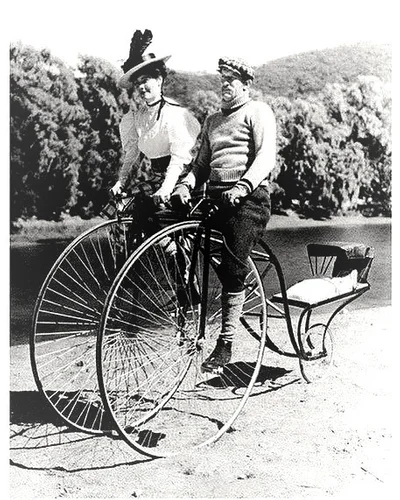
* PV-Folien produce e.g.:
ARMOR solar power films, Heliatek ®, Flisom, Alwitra-Evalon cSi ®, FirstSolar®, Nanosolar ®.** USB-Plog, Navi-Integration and a hands-free system, combined with the charging status, kilometer- and speedometer display, in a folding and removable display (next to wide rear-view mirrior) in the roof, would also be good additional options.
Locally adapted fahrRAD productions could also be realised by emerging countries.
In any case, all 10 innovations are available free of charge. Low-cost alternative mobility that avoids the disadvantages of fossil fuels and road construction would certainly be welcome and necessary there.
For feedback, critic und technical : www.earthsolar.at or +43 19195724


© by Michael Thalhammer - July 2013 - Technically updated, Vienna, 03.11.2021
=====
Locally adapted fahrRAD productions could also be realised by emerging countries.
In any case, all 10 innovations are available free of charge. Low-cost alternative mobility that avoids the disadvantages of fossil fuels and road construction would certainly be welcome and necessary there.
For feedback, critic und technical : www.earthsolar.at or +43 19195724


© by Michael Thalhammer - July 2013 - Technically updated, Vienna, 03.11.2021
======================


